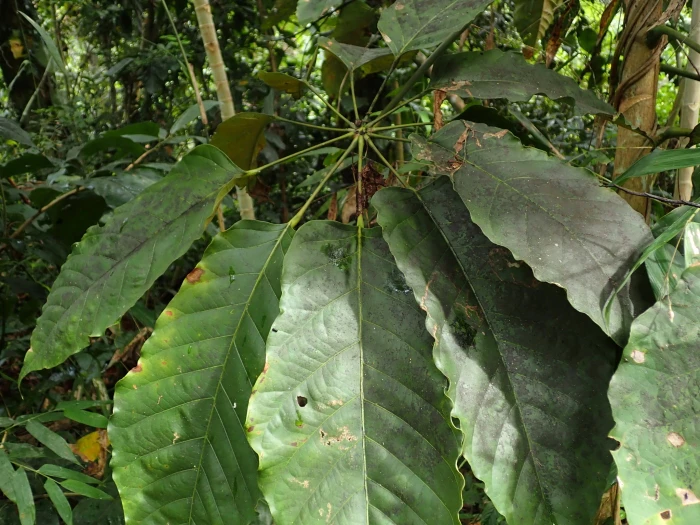Yagrumo Macho
(Didymopanax morototoni)
Yagrumo Macho (Didymopanax morototoni)
/
/

Daniel Cahen
CC BY 4.0
Image By:
Daniel Cahen
Recorded By:
Copyright:
CC BY 4.0
Copyright Notice:
Photo by: Daniel Cahen | License Type: CC BY 4.0 | License URL: http://creativecommons.org/licenses/by/4.0/ | Rights Holder: Daniel Cahen | Publisher: iNaturalist | Date Created: 2020-02-05T15:53:45-08:00 |

























Estimated Native Range
Climate Requirements for Parkersburg, West Virginia
| This Plant | Your Site | Plant Suitability for Your Location | ||
|---|---|---|---|---|
| • Precipitation | 10" - 173" | 41" | Aquatic | Aquatic |
| • High Temp. | 48°F - 98°F | 86°F | Your summer temperatures are normal for this plant. | Excellent |
| • Low Temp. | 17°F - 74°F | 21°F | Your winter temperatures are normal for this plant | Excellent |
This plant should grow well at your location with about N inches per year (Y minutes per month) of irrigation.
Summary
Didymopanax morototoni, commonly known as yagrumo macho, is a semi-deciduous tree native to a variety of habitats such as tropical rainforests, lower montane forests, and occasionally in disturbed areas within its range in southern Mexico, the Greater Antilles, Central America, and South America. It typically grows to a height of 20-30 meters with a straight trunk and a rounded canopy. The leaves are large, palmate, and provide a lush green appearance. Yagrumo macho is not widely known for its flowers, as they are small and inconspicuous, but it does produce fruit that is utilized by local wildlife.
Yagrumo macho is primarily valued for its durable, workable wood, which is used in construction and carpentry. It is not commonly cultivated for ornamental purposes, but when it is, it requires a tropical or subtropical climate with adequate moisture. It thrives in well-drained soils and can tolerate a range of light conditions from full sun to partial shade. While not a common choice for urban planting, it can be used in reforestation projects and rural landscaping. Its rapid growth rate and adaptability to different soil types make it a useful species for land recovery efforts.CC BY-SA 4.0
Yagrumo macho is primarily valued for its durable, workable wood, which is used in construction and carpentry. It is not commonly cultivated for ornamental purposes, but when it is, it requires a tropical or subtropical climate with adequate moisture. It thrives in well-drained soils and can tolerate a range of light conditions from full sun to partial shade. While not a common choice for urban planting, it can be used in reforestation projects and rural landscaping. Its rapid growth rate and adaptability to different soil types make it a useful species for land recovery efforts.CC BY-SA 4.0
Plant Description
- Plant Type: Tree
- Height: 40-80 feet
- Width: 15-30 feet
- Growth Rate: Moderate
- Flower Color: White
- Flowering Season: Spring, Summer
- Leaf Retention: Evergreen
Growth Requirements
- Sun: Full Sun, Part Shade
- Water: Medium, High
- Drainage: Medium, Slow
Common Uses
Bee Garden, Bird Garden, Border Plant, Butterfly Garden
Natural Habitat
Native to tropical rainforests and lower montane forests
Other Names
Common Names: Morototo, Sietecueros, Llagrumo Macho, Matchwood, Guayabo blanco
Scientific Names: Didymopanax morototoni, Aralia micans, Aralia micans, Didymopanax calophyllum, Didymopanax calophyllus, Didymopanax chrysophyllus, Didymopanax micans, Didymopanax morototoni var. poeppigii, Didymopanax morototoni var. sessiliflorus
GBIF Accepted Name: Didymopanax morototoni